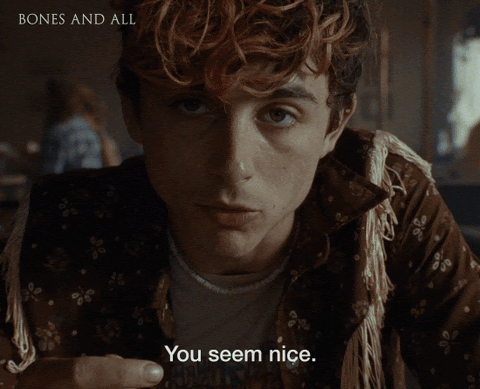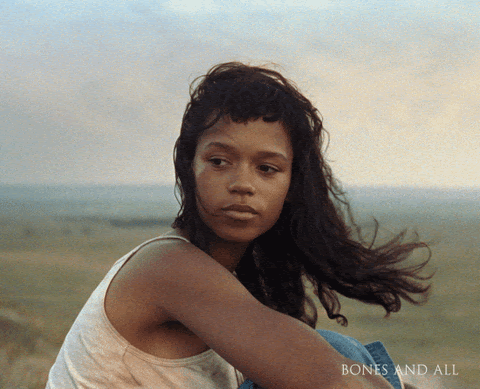***Contains spoilers. Can you handle the truth?
Now making a film about cannibalism without it being utterly offensive for shock value was sure of a challenge for director Luca Guadagnino. He successfully got the audience to feel remorse for the protagonists regardless of their violent actions. Yet, revolving it around cannibalism was just not my vision of how themes of self-acceptance and identity thrive in coming-of-age stories. It becomes too ambiguous of a context to fulfill this idea successfully and was mediocrely executed from the plot being so predictable—it had the potential to eat, but it just nibbled.

The linear story sets in the late 80's Reagan era and follows Maren (Taylor Russell), a teenage girl searching for her mother, who abandoned her and her father for unknown circumstances. Throughout this journey of traveling around the depressing, graveyard-like outskirts of the Midwest, she meets other “eaters” along the way. One, in particular, is a young guy named Lee (Timothée Chalamet), who sparks one romantic and emotional connection. Lee becomes a guide for her since he seems like an expert in being a cannibal. They soon latch on to each other and reveal how co-dependent they are in this life, which stops them from accepting themselves and understanding their violent instincts deeper.

Each cannibal within the film resembled a different form of identity acceptance. Maren becomes vulnerable and inexperienced and struggles to accept her true identity as a cannibal. The audience sees this aspect when she meets an older man named Sully, who claims he can “smell her from a mile away.” During her first witness of a dead body to feast on, she becomes shown in shadows, which implies her two identities of her true form and her repressed state of being a cannibal. This dual expression of her character is captured beautifully by cinematographer Khachaturan, having the mutilated dead body shown behind her in bright natural light while the camera shows her facing towards the audience in silhouette.
In contrast, the character Sully refers to himself in 2nd person emphasizing his lack of identity acceptance, and latches onto others like Maren for her affirmation. Sully feels alienated as a cannibal and needs other cannibals to feel accepted; he even collects the hair of his victims to resemble how he steals others' identities to fill a gap that he cannot grasp.

On the other hand, Lee fakes his identity acceptance; he thinks he knows who he is but can’t recognize it. Lee is able to justify his cannibalistic behaviors to Maren as killing for food becomes natural and necessary for people like them. Yet, Maren feels they should practice being “normal people” to forget their true identities. It becomes easier for Lee to show no remorse after killing people, but paired with Maren, it becomes difficult as she is the opposite. Her character becomes more outwardly repressed and rejects the cannibalistic lifestyle, but Lee’s character tries to push his repression down, and it comes out through impulsive behavior. One scene shows him looking in the mirror while dancing, and he soon gains composure from this and decides to shower after seeing dried blood from his victim on his chest. The film touches on the subconscious minds of the two characters as well, displaying Maren’s dream sequences as snippets of flashbacks of her violent actions that she deeply regrets. Lee’s dreams are imaginary untamed violent compulsions, unlike Marens.
One scene in the film references the title's meaning, as they meet two other campers, one an “eater” and the other just a cannibal by choice.

The real eater asks if they have ever eaten someone, “bones and all,” this becomes a horrifying subject for Maren and Lee. They also find out the camper's friend is a cannibal by choice, and Maren and Lee become angry that the friend chooses this type of life, having the opportunity to be normal. As the teenagers try to escape from them, the real cannibal chases them as a thematic element of showcasing how Maren and Lee refuse their acceptance after meeting someone who has. The film even showcases Lee killing the two campers in his dream as an expression of his anger and jealousy that he can’t accept his identity like they did. Eating bones becomes a rite of passage that Maren, Lee, or Sully never complete, so they become stuck in this endless and deteriorating journey of never reaching self-acceptance.
Ultimately, monster romance is not usually my thing, and if I wanted to watch a film about self-acceptance and identity, this wouldn’t be one of them. What was clever about the film was how Khachaturan captured this search for identity from the endless landscape scenery of the Midwest and how Luca could assign this different identity struggles to each character. Who doesn't love the aesthetically pleasing imagery of cannibals making out in grassland fields? Yet, the last 10 minutes were rushed in contrast to the awkward pacing in the entirety of the film. Besides the graphic scenes, I don’t have to go into depth for; everything else was just boring and confusing. The characters' choices, in the end, switched to companionship from identity searching. Still, there was no build-up from Maren and Lee to establish a deep emotional connection with each other. Having one of them commit to something drastic didn’t make sense. Overall, this film becomes a great example of how simple cinematography can encapsulate such emotional depth from visuals, duality, address power dynamics, and the empty and crumbling 80s America in this road trip movie, which by the way, it being Kodak film instead of digital, emulates that ~vintage~ aspect. But……..good cinematography does not associate with a great story.
